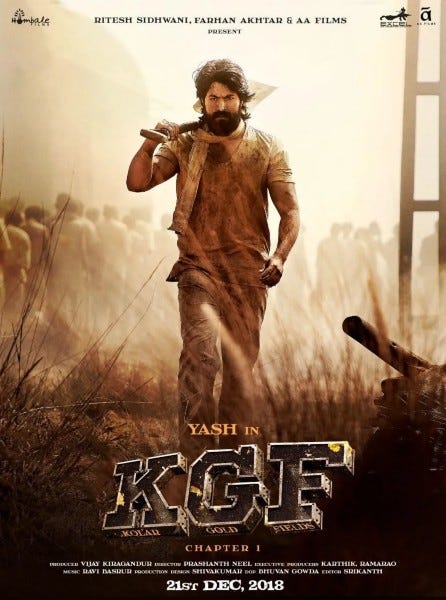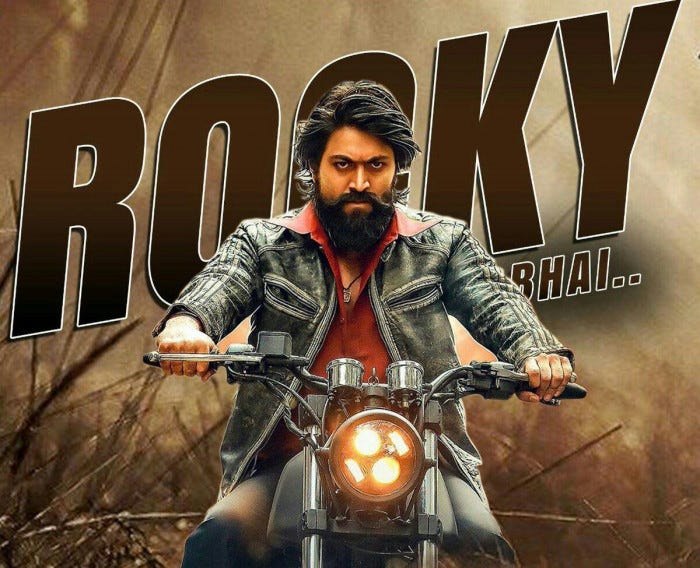KGF Chapter 1 - "Powerful People Come from Powerful Places"
Kolar Gold Field - KGF C1- Rocky, who returns to his birthplace to save his people who work as slaves in the gold mines. The film showcases his journey as he fights against the corrupt system.
KGF Chapter 1: Two significant events happen in 1951 - the birth of the hero, Raja Rocky, and the discovery of gold ore in southern Mysore State. The hero is brought up in poverty and moves to Mumbai to become a mafia don, fulfilling his mother's wish to see him rich and powerful. A banned book about the Kolar Gold Fields details events from 1951-2018.
Genres: Action, Crime, Drama, Thriller
Runtime: 2h 36m (156 min)
Language: Kannada (original)
You can enjoy watching KGF in any language, even if you're not familiar with Kannada as it is available in multiple languages. Personally, I watched it in Tamil and had a great time.
Released date: December 20, 2018 (USA)
Cast
Sex & Nudity
There Is Nothing Sexual In this movie.
In An Item Song Dancer's Belly Is Visible. No nudity Is Shown
KGF Chapter 1 is a period film that takes place in 1951 and is set against the backdrop of the Kolar Gold Fields in southern Mysore State. The film follows the birth of the protagonist, Raja Rocky Krishnappa Bairya, who is born to a poor young woman named Shanti on the same day that gold ore is discovered in the region. Rocky's mother wishes for her son to become rich and powerful, and he goes to Mumbai to become a mafia don. The film explores Rocky's journey as he returns to his birthplace to fulfill his mother's wishes and to free his people from the age-old slavery. The film also highlights the challenges and obstacles that Rocky faces as he tries to become a powerful figure. With its compelling characters, motivating themes, and unexpected twists, KGF Chapter 1 is a thrilling and intense movie that is sure to keep you on the edge of your seat.
The movie KGF focuses on themes of power, ambition, and the consequences of unchecked greed. The protagonist, Rocky, rises from poverty to become the king of the gold mines, but along the way, he realizes the cost of his actions and the people he has hurt. The film addresses the issue of wealth disparity and the corrupting influence of power. The significance of the film lies in its exploration of the human desire for wealth and the consequences of its pursuit. KGF stands out in its genre by blending elements of action, drama, and emotional depth, making it a well-rounded and impactful film.
KGF features a visually stunning and adrenaline-fueled style, with cinematography captured using ARRI ALEXA SXT and RED Epic cameras and lenses from Zeiss. The film's music and sound mix, including Dolby Atmos and Dolby Surround 7.1, adds to the intensity of the action scenes and emotional moments. This approach to style contributes to the film's overall impact and makes it a standout in the action genre.
I personally can't say I love the KGF movie, but I did enjoy watching it because of its mass action scenes and Rocky's courage in facing obstacles and rising to success through self-discipline. His story of being born poor but striving to fulfill his mother's wish for him to be rich is one of my favorite parts. However, as with many Indian movies, the hero often seems invincible and can take down minions with ease, despite the minions sometimes being more muscular than the Hero. The villain only beats the hero until the hero gets angry. What do you say about this trend in Indian cinema?
But I have to say that those action scenes combined with the music, sounds, and dialogues pump adrenaline. It's almost feels like lining in that reality where I feel like I'm fighting alongside the characters. If you have watched movies like Baahubali, KGF, RRR, Vikram, etc., you would know what I'm talking about.
Prime Video: K.G.F: Chapter 1 (Hindi)
Prime Video: K.G.F: Chapter 1 (Kannada)
Prime Video: K.G.F: Chapter 1 (Tamil)
Music Videos
Parts I Enjoyed
My Newsletter Structure (Basic)
Paragraph 1: Introduction
Paragraph 2: Plot Summary
Paragraph 3: Themes and Significance
Paragraph 4: Style and Approach
Paragraph 5: Final Thoughts






